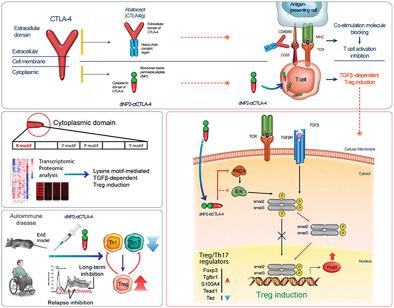Our official English website, www.x-mol.net, welcomes your feedback! (Note: you will need to create a separate account there.)
In Vivo Induction of Regulatory T Cells Via CTLA-4 Signaling Peptide to Control Autoimmune Encephalomyelitis and Prevent Disease Relapse
Advanced Science ( IF 15.1 ) Pub Date : 2021-05-05 , DOI: 10.1002/advs.202004973 Gil-Ran Kim 1 , Won-Ju Kim 1 , Sangho Lim 2 , Hong-Gyun Lee 1 , Ja-Hyun Koo 1 , Kyung-Ho Nam 1 , Sung-Min Kim 3 , Sung-Dong Park 1 , Je-Min Choi 4
Advanced Science ( IF 15.1 ) Pub Date : 2021-05-05 , DOI: 10.1002/advs.202004973 Gil-Ran Kim 1 , Won-Ju Kim 1 , Sangho Lim 2 , Hong-Gyun Lee 1 , Ja-Hyun Koo 1 , Kyung-Ho Nam 1 , Sung-Min Kim 3 , Sung-Dong Park 1 , Je-Min Choi 4
Affiliation

|
Regulatory T cells play a key role in immune tolerance to self-antigens, thereby preventing autoimmune diseases. However, no drugs targeting Treg cells have been approved for clinical trials yet. Here, a chimeric peptide is generated by conjugation of the cytoplasmic domain of CTLA-4 (ctCTLA-4) with dNP2 for intracellular delivery, dNP2-ctCTLA-4, and evaluated Foxp3 expression during Th0, Th1, Treg, and Th17 differentiation dependent on TGF-β. The lysine motif of ctCTLA-4, not tyrosine motif, is required for Foxp3 expression for Treg induction and amelioration of experimental autoimmune encephalomyelitis (EAE). Transcriptome analysis reveals that dNP2-ctCTLA-4-treated T cells express Treg transcriptomic patterns with properties of suppressive functions. In addition, the molecular interaction between the lysine motif of ctCTLA-4 and PKC-η is critical for Foxp3 expression. Although both CTLA-4-Ig and dNP2-ctCTLA-4 treatment in vivo ameliorated EAE progression, only dNP2-ctCTLA-4 requires Treg cells for inhibition of disease progression and prevention of relapse. Furthermore, the CTLA-4 signaling peptide is able to induce human Tregs in vitro and in vivo as well as from peripheral blood mononuclear cells (PBMCs) of multiple sclerosis patients. These results collectively suggest that the chimeric CTLA-4 signaling peptide can be used for successful induction of regulatory T cells in vivo to control autoimmune diseases, such as multiple sclerosis.
中文翻译:

通过 CTLA-4 信号肽体内诱导调节性 T 细胞控制自身免疫性脑脊髓炎并预防疾病复发
调节性T细胞在对自身抗原的免疫耐受中发挥关键作用,从而预防自身免疫性疾病。然而,目前还没有针对Treg细胞的药物被批准用于临床试验。在此,通过将 CTLA-4 (ctCTLA-4) 的胞质结构域与用于细胞内递送的 dNP2 缀合生成嵌合肽 dNP2-ctCTLA-4,并评估 Th0、Th1、Treg 和 Th17 分化过程中 Foxp3 的表达依赖于转化生长因子-β。Foxp3 表达需要 ctCTLA-4 的赖氨酸基序,而不是酪氨酸基序,以诱导 Treg 并改善实验性自身免疫性脑脊髓炎 (EAE)。转录组分析表明,dNP2-ctCTLA-4 处理的 T 细胞表达具有抑制功能特性的 Treg 转录组模式。此外,ctCTLA-4 的赖氨酸基序和 PKC- η之间的分子相互作用对于 Foxp3 的表达至关重要。尽管 CTLA-4-Ig 和 dNP2-ctCTLA-4 体内治疗均改善了 EAE 进展,但只有 dNP2-ctCTLA-4 需要 Treg 细胞来抑制疾病进展和预防复发。此外,CTLA-4信号肽能够在体外和体内以及多发性硬化症患者的外周血单核细胞(PBMC)中诱导人类Tregs。这些结果共同表明,嵌合 CTLA-4 信号肽可用于成功诱导体内调节性 T 细胞,以控制自身免疫性疾病,例如多发性硬化症。
更新日期:2021-05-05
中文翻译:

通过 CTLA-4 信号肽体内诱导调节性 T 细胞控制自身免疫性脑脊髓炎并预防疾病复发
调节性T细胞在对自身抗原的免疫耐受中发挥关键作用,从而预防自身免疫性疾病。然而,目前还没有针对Treg细胞的药物被批准用于临床试验。在此,通过将 CTLA-4 (ctCTLA-4) 的胞质结构域与用于细胞内递送的 dNP2 缀合生成嵌合肽 dNP2-ctCTLA-4,并评估 Th0、Th1、Treg 和 Th17 分化过程中 Foxp3 的表达依赖于转化生长因子-β。Foxp3 表达需要 ctCTLA-4 的赖氨酸基序,而不是酪氨酸基序,以诱导 Treg 并改善实验性自身免疫性脑脊髓炎 (EAE)。转录组分析表明,dNP2-ctCTLA-4 处理的 T 细胞表达具有抑制功能特性的 Treg 转录组模式。此外,ctCTLA-4 的赖氨酸基序和 PKC- η之间的分子相互作用对于 Foxp3 的表达至关重要。尽管 CTLA-4-Ig 和 dNP2-ctCTLA-4 体内治疗均改善了 EAE 进展,但只有 dNP2-ctCTLA-4 需要 Treg 细胞来抑制疾病进展和预防复发。此外,CTLA-4信号肽能够在体外和体内以及多发性硬化症患者的外周血单核细胞(PBMC)中诱导人类Tregs。这些结果共同表明,嵌合 CTLA-4 信号肽可用于成功诱导体内调节性 T 细胞,以控制自身免疫性疾病,例如多发性硬化症。



























 京公网安备 11010802027423号
京公网安备 11010802027423号